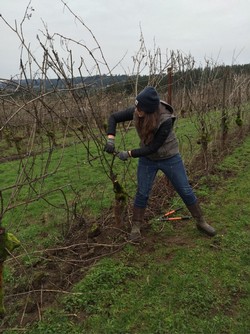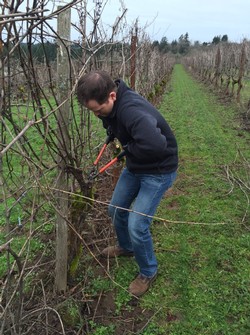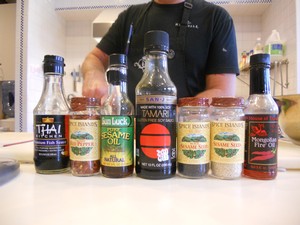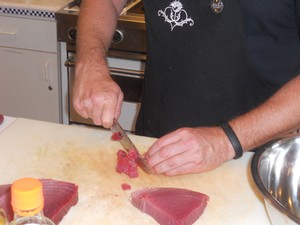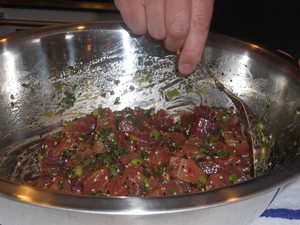The effects of water on tannin levels in grape development - Part three: Irrigation
In February I had the pleasure of speaking at the Oregon Wine Industry Symposium on a panel talking about grape and wine tannins. Anna Matzinger, Steve Price and I wanted to clarify what tannins are, how their levels in wine affect texture and structure of the wine, where tannins come from, the role of soil moisture on grape tannin levels and how harvest date affects quality of tannins.
I was tasked with talking about the relationship between soil water status and grape tannin levels. It was a great opportunity to improve my understanding of the relationship, and helped me come to terms with the difference between dry farming here in the Willamette Valley and the irrigated vineyards in Southern Oregon. On dry farmed sites factors like soil type, depth and texture, along with the seasonal rainfall have a profound effect on tannin level. In vineyards where there isn’t enough soil moisture to sustain the vines for the entire season, supplementary irrigation is needed. In those vineyards you have more control over the tannin levels of the grapes. To understand this topic and prep for my panel discussion, I studied three key disciplines: 1) soil science; 2) plant physiology; and 3) irrigation management.
Before I get into this I will say that I think the Internet is great for researching topics but I really like books.
PART THREE: IRRIGATION
By controlling the water applied to plants through irrigation you can study its effects on the growth of the vines, yield and also the fruit chemistry. In dry farmed situations it’s very hard to control the water therefore it is harder to study the effects of water on the vines and fruit.
There have been a lot of studies on irrigation management all over the world and the effects of varying irrigation levels at different points throughout the season. What researchers have found is that by applying less water than the vines are losing to ET between fruit set and veraison, you can control the vine growth and vigor, increase the exposure of the fruit and reduce the berry size. All of these factors help to increase the concentration of tannins and other phenolic compounds in the grapes, desirable in red grapes but less desirable in white grapes.
This understanding has led to wide spread adoption of the irrigation practice called Regulated Deficit Irrigation (RDI) and it is used to improve the quality of red wine grapes. To learn more about RDI visit this site: http://cru.cahe.wsu.edu/CEPublications/EM061E/EM061E.pdf.
The effects of water on tannin levels in grape development - Part two: Plant physiology
In February I had the pleasure of speaking at the Oregon Wine Industry Symposium on a panel talking about grape and wine tannins. Anna Matzinger, Steve Price and I wanted to clarify what tannins are, how their levels in wine affect texture and structure of the wine, where tannins come from, the role of soil moisture on grape tannin levels and how harvest date affects quality of tannins.
I was tasked with talking about the relationship between soil water status and grape tannin levels. It was a great opportunity to improve my understanding of the relationship, and helped me come to terms with the difference between dry farming here in the Willamette Valley and the irrigated vineyards in Southern Oregon. On dry farmed sites factors like soil type, depth and texture, along with the seasonal rainfall have a profound effect on tannin level. In vineyards where there isn’t enough soil moisture to sustain the vines for the entire season, supplementary irrigation is needed. In those vineyards you have more control over the tannin levels of the grapes. To understand this topic and prep for my panel discussion, I studied three key disciplines: 1) soil science; 2) plant physiology; and 3) irrigation management.
Before I get into this I will say that I think the Internet is great for researching topics but I really like books.
PART TWO: PLANT PHYSIOLOGY
No one has written a better book on grapevine anatomy and physiology than Markus Keller: The Science of Grapevines, 2010. This was my go to resource for trying to understand how the plant responds to water.
Plants uptake water though their roots via osmosis. It is transported up the xylem to the leaves and out through the stomata. The negative pressure (tension) in the stomata pulls the water from the roots to the leaves. The tension in the leaves has to be greater that the tension in the xylem and the soil to effectively move the water. Therefore the tension in the soil affects the tension in the plant.
An increase in soil tension due to evaporation and transpiration (evapotranspiration or ET) causes a higher increase in xylem tension which, in turn, slows shoot growth and can stop shoot growth all together.
The drying of the soil also causes abscisic acid to be produced (ABA) in the roots. ABA is then transported around the plant where it has many effects.
- ABA helps regulate stomatal conductance. An increase in ABA closes the stomata so the plant loses less water.
- ABA works against Auxins which stimulate cell elongation and apical dominance. ABA production, like xylem tension helps to slow and stop shoot growth.
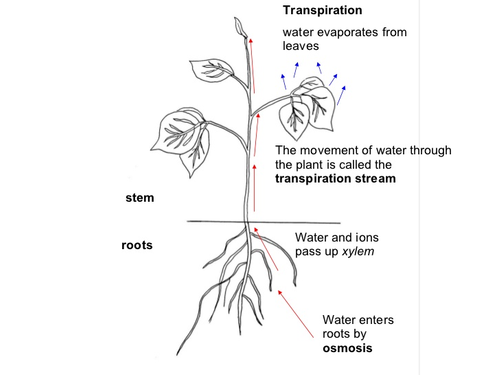
Oregon Wine Symposium Part Two: Climatology
Held every year, the Oregon Wine Symposium is marked as "the premier educational event and trade show for the Northwest wine community." This was the first year that I had the pleasure to attend and following this past harvest, I was looking forward to lectures on some pretty hot topics in the Willamette Valley during the 2015 season. For locals you might have picked up on my pun there, but for the uninitiated, let's just say that year after year the Willamette Valley never ceases to surprise with the forecast. We'll get to that in just a moment, but first, an overview.
The two day event is organized by the Oregon Winegrowers Association and is held at the Oregon Convention Center in Portland. It features more than 200 exhibitors on the trade show floor and pulls in guest speakers at the top of their fields, from local icons to world renowned professionals. And perhaps one of the coolest components is that at any point during the symposium you might just bump into one of said icons, personal wine heroes, or the like.
This year, the lineup of speakers ranged from Patrick Criteser, CEO of Tillamook Country Creamery, to Rich DeScenzo, Group Leader of Microbiology at ETS Laboratories - essentially big picture business to DNA fingerprinting yeast cells in a winery...you get the idea. To say that there is something for every sector of this industry represented at the Symposium is an understatement. That said, there seemed to be one topic that transcended every niche of the wine business because it affects us all - climatology reports.
Dr. Greg Jones, Professor and Research Climatologist at Southern Oregon University, returned this year to provide a wrap-up of the 2015 growing season and some projections for what's ahead in 2016. Slide after slide of his presentation showed us that last year was one for the record books - not just Portland experiencing the most 90 degree days in a calendar year, but 2015 taking the cake as the hottest year in history. With much of the Northwest being victim to an El Niño pattern, we've seen the temperature of the ocean increase, which is even more drastic than land heating. The Arctic Sea ice extent is at its lowest level ever and the temperature gradient between the poles and the equator has dropped, resulting in the jet stream becoming more pronounced. Add to that a statistic like a record breaking accumulation of rainfall in Oregon between December 2015 and February 2016, it's no surprise to see meteorologists, viticulturists, winemakers, and even hospitality managers scratching their heads and wondering what lies ahead.
Queue the projections for 2016: To put it simply, Dr. Jones says to expect more of the current trend. Anywhere from 2012 to 2015 heat or beyond. With California already seeing bud break, I can't imagine we'll be far behind. Karen Peterson, Viticulturists at REX HILL & A to Z Wineworks, reported this morning that we are already seeing wooly bud stage in some vineyards! Will it be another early harvest in 2016? Will the rain let up and tourist season kick off early in the Valley? I guess we'll just have to wait and see. One thing is for certain, we can look forward to another year of surprises and I suspect another seminar full of coverage of what went down at next year's Oregon Wine Symposium.
Learning to Prune
I don’t have a green thumb. Far from it. I’ve been known to kill cactus. So you might imagine my apprehension when Karen, our Viticulturist, handed me her pruning shears as we stood in the REX HILL Vineyard this misty February morning. I didn’t anticipate our morning field trip and lesson in vineyard maintenance would involve hands-on practice.
Of course, I needn’t have worried. Karen showed us how she and our vineyard team prune back last year’s growth leaving behind a few select canes that will become the backbone for this year’s crop. The process is critical for regulating the number of shoots that will grow this coming season and for keeping excellent fruit quality. Winter pruning kicks off the year for the vineyard team and they work through the cold and the wet to ready the vines for another growing season.
Several factors are taken into consideration including cane thickness, location relative to the guidewires, and number of buds in order to decide what to cut, where to cut, and what to leave alone. Experienced workers can assess and prune a vine in a minute or two. I, on the other hand, took ten minutes just to confirm with Karen (twice) that I was cutting correctly. I didn’t want to add Pinot Noir to the list of plants that perished at my hand.
Thankfully, my vine is in good health (even after I was through with it) and has three healthy canes through which it will produce fruit this year. Is it Spring yet?
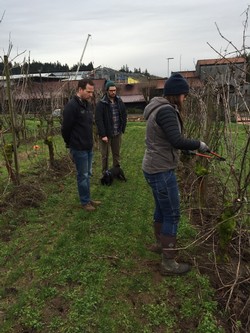
| Karen showing Tom & Jonathan how to prune a vine. | Karen pruning a vine at the REX HILL Estate Vineyard. |
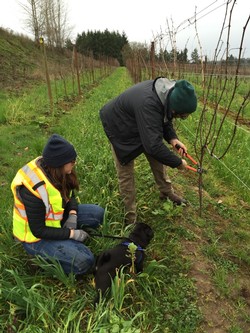
| Tom taking a turn at pruning while Karen & Batpug (Tom's dog) oversee. | Jonathan's turn to prune part of the REX HILL Estate Vineyard. |
Soils!
In celebration of the UN naming 2015 the International Year of Soils (IYS), I think it is only fair to write about soils; however, there is only one way to do it justice...a SOIL SERIES! So, we will be bringing a series of soil related blog postings that will hopefully get everyone just as excited as we are about soils.
To kick off the series, I'll share with you an epiphany I had while reminiscing about the soil classes I took during my undergrad: When describing a wine, many of the terms used to identify specific qualitites of that wine are shared by soil scientists when describing soils. Our Tasting Room Manager, my fellow Karen at REX HILL, and I have put together a table of descriptors for your enjoyment.
| DESCRIPTOR | SOIL | WINE |
| Aroma | A healthy soil will have a "good" aroma - if you're getting off aromas from a soil, that's a clue that there's something going on with it. | Also known as 'the nose' of a wine, aroma is what the wines smell like, from the "good" aromas of fruit to floral to earthy components. If the wine has an off aroma, it could be an indication of a wine fault. |
| Structure | Structure is simply the arrangement of soil aggregates. Soil structure influences water, air and nutrient relations in the soil. Promoting good soil structure is crucial to keeping a vineyard healthy. | Structure refers to the relationship and, ultimately, the balance of different components in wine such as acid, tannin, alcohol, body, texture, etc. A good structured wine has a greater potential to age longer. |
| Texture | Texture refers to the percent of clay, silt and sand particles in the soil. Soil scientists are often able to tell a lot about a soil based on how it feels (i.e. a soil with a higher percent of sand may feel gritty). | Texture is a component of structure, and is the general sensation or overall mouthfeel of the wine that incorporates the weight, body, tannins, etc. (i.e. a wine with more tannin may feel chalky or grippy on your palate). |
| Acidity | Soil acidity is important to take into consideration when planting any crop, and can be altered by many farming practices. Blueberries, for example, thrive in acidic soils (a pH of 4.5 - 5ish), whereas wine grapes need a slightly higher pH soil (5.5 - 6.5ish). The soil pH affects the availability of nutrients in the soil. If plants that are not suited to a soil's specific pH are planted, nutrient deficiencies and/or toxicities will become apparent, and the plan will not thrive. | Acidity is another part of the structure of wine, and it refers to the amount of perceived acid in the wine. Without acidity, wines taste flat, soft or flabby, but with too much acidity, wines can taste tart, sharp or sour. |
| Balance | A loaded term when it comes to soils - this is a drastic over-simplification, but a healthy balanced soil works like a well-oiled machine. In agriculture, we have to be very aware of the consequences management hsa on the soil's natural systems lest we throw a balanced soil system out of balance. | A loaded term when it come sto wines as well - on a broad scale, balance refers to the overall perception of the structure at the end of each taste. It is the relationship equilibrium of all the components in wine (acid, tannin, alcohol, body, texture, etc.). When no one component sticks out more than another, the wine has balance, a sense of elegance and completeness, which is a hallmark of great wines. |
A Kid at the Adult Table
The International Pinot Noir Celebration (IPNC) is a huge draw to Oregon wine country for producers and consumers alike. I’ve heard a lot about it since I moved to Oregon in 2000, but working in the industry makes late July a challenging time to get away from the winery. We tend to be simultaneously wrapping up bottling of the previous vintage and preparing for the upcoming one.
In 2014, I finally had a chance to attend the Grand Seminar at IPNC, which was titled “Pinot Noir and the Doors of Perception.” This was of particular interest to me, as I have been exposed to some very in-depth olfactory training over the past seven years. I appreciated Harvard historian Steven Shapin’s comments on the evolution of wine perception and with it, the continually morphing idea of what makes a good wine. Birmingham chef, Frank Stitt, reminded many of us who need no reminder that the right wine with the right food can broaden our gustatory horizons. I was most looking forward to Elaine Brown’s visual depiction of how wine tastes. Her cartoons are informational as well as interesting, and she has received a lot of press for her wine tasting notes in the form of drawings. It is absolutely time that this is a recognized form of wine description, and she is by no means the first to visually represent flavor.
When I worked at Opus One, the Assistant Viticulturist was excellent at her job in the vineyard, but had not spent much time developing a vocabulary for her palate. When she was asked to participate in blending sessions with the winemaking team, she was initially intimidated and struggled to attach words to her perception. I noticed, sitting next to her in a tasting one day, that she was drawing small forms at the bottom of her tasting sheet and assigning words later. As I began to regularly observe her drawings alongside her description, I grew to understand the language of her art. She told me it was simply much more natural for her to capture taste through pictures.
Similarly, in an Olfaction Seminar with Alexandre Schmitt in 2011, I sat next to Patrick Reuter of Dominio IV wines. A very creative person, Patrick sat among a group of 12 other winemakers, each with a pen or pencil and paper, and Patrick spread out his set of crayons. We were learning to describe and identify aromas, but Patrick was also assigning them color and shape.
Winemaking is the intersection of art and science. For most of us, the process skews more heavily one way or the other, but this meeting of left and right brain has always been, to me, a central tenet of the craft. Tasting wine (especially within the industry) is so often technical. Many consumers strive to accurately identify color, aroma, acid, alcohol content. There is an entire profession devoted, essentially, to the blind identification of vintage, varietal, region, and producer, or at the very least whether the vintage was warm or cool, whether the wine is new world or old, and whether there is a flaw of some sort in the wine. But it seems only natural that there could be a more creative way to appreciate wine. I have challenged myself to draw what I taste more regularly, and I challenge you to do the same the next time you sit down with a glass of wine. You may surprise yourself at either your creative skill or the accuracy with which you are able to capture your perception through art.
What's missing from your end-of-summer get together?
Late summer in Oregon is all about our abundant harvest. Blueberries, boysenberries, corn, tomatoes, chilies, squash and more give us a reprieve from the ubiquitous kale of winter (while salmon begin their fall run even in August close to the coast in Astoria) to lay a foundation for a wild array of dishes from raw to grilled. Fresh and bright is the order of the day, and the best wines reflect that. Acidity trumps tannin, being more suited for lighter, summery fare - like a squeeze of lemon on a bed of green - so our cool-climate whites and reds (Pinot Noir, Gamay, Pinot Gris, Riesling, Chardonnay) with less oak will always pair elegantly, and not overwhelm a dish's nuance.
A summer favorite at the winery, we recommend Ahi Poké paired with Chardonnay or Pinot Gris as the perfect pairing to start your end-of-summer get together.
Ahi Poké
Serving Size: 15
Prep Time: 2 hours 20 minutes minimum
Wine Pairing: 2012 REX HILL Willamette Valley Seven Soils Chardonnay
2012 REX HILL Jacob-Hart Vineyard Pinot Gris
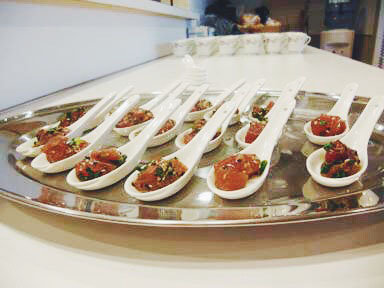
Ingredients
20 oz fresh ahi tuna
1 bunch of green onions
1 shake of fish sauce
1 1/2 tsp Thai chili paste
2 tbsp pure sesame oil
1 1/2 tbsp soy sauce
1 1/2 tbsp sesame seeds double the amount if choosing not to use black sesame seeds
1 1/2 tbsp black sesame seeds optional
1 tbsp Mongolian fire oil
Directions
- Clean off any remaining bits of skin or sinew.
- Dice ahi in 1 1/2-inch chunks and place it in a medium-sized bowl.
- Chop up green onions and add it to the bowl.
- Add fish sauce, sesame oil, soy sauce and Mongolian fire oil. Stir.
- Add sesame seeds & Thai chili paste. Stir.
- Taste. Add ingredients as necessary.
- Cover & refrigerate for a minimum of 2 hours before serving.
- Serve with Kim Chee cucumbers, zucchini squash spaghetti, or by itself.
Recent Posts
-
October 12, 2018
-
June 7, 2018
-
October 30, 2017
-
October 23, 2017
-
September 13, 2017
-
April 17, 2017
-
July 21, 2016
-
June 2, 2016
-
May 25, 2016
-
May 18, 2016
Blog Categories
Blog Archives
Our Writers
- Leanne Bellncula (2)
- Shelli Brinson Fowler (1)
- Tom Caruso (2)
- Ryan Collins (20)
- Bill Hatcher (10)
- Deb Hatcher (2)
- REX HILL (59)
- Kelly Irelan (1)
- Carrie Kalscheuer (3)
- Jonathan Lampe (3)
- Karina Lopez (1)
- Meredith McGough (1)
- Katie McLennan (2)
- Charlotte Mischel (2)
- Karen Peterson (2)
- Olivier Prost (2)
- Tom Reed (1)
- Emily Sadler (1)
- Sam Tannahill (2)
- Mike Willison (4)



